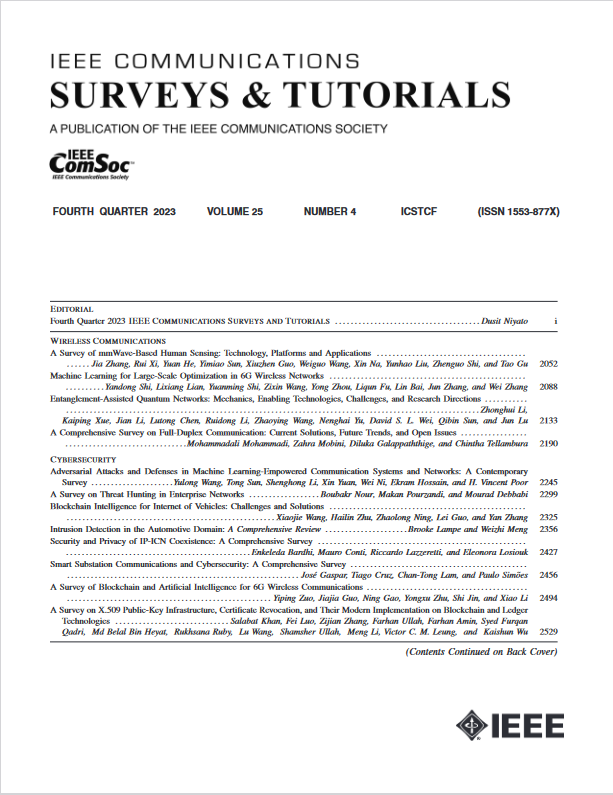无人驾驶飞行器(UAV)的轨迹预测技术:全面调查
IF 34.4
1区 计算机科学
Q1 COMPUTER SCIENCE, INFORMATION SYSTEMS
引用次数: 0
摘要
无人机在环境监测、基础设施检查、灾害响应、野生动物保护、监视和侦察任务等各个领域都有显著的意义。预测无人机的未来状态是无人机在动态环境中安全高效运行的关键。无人机轨迹规划是无人机操作的一个关键方面,因为它决定了无人机将如何导航、执行任务和避开障碍物。无人机可以有不同程度的自主操作,它们可以由人类控制,也可以通过机载自动驾驶软件自动控制。虽然现有的研究主要集中在无人机的轨迹规划方法上,但关于将预测能力集成到轨迹规划中的文献存在明显的空白,这突出表明需要对与轨迹规划相关领域相关的无人机轨迹预测方法进行全面审查。本文对自主无人机的弹道预测方法进行了综合比较分析。从精确的问题定义和算法分类开始,我们的研究深入研究了植根于传统数学模型、经典机器学习、深度学习和强化学习模型的评估方法。本文章由计算机程序翻译,如有差异,请以英文原文为准。
Trajectory-Prediction Techniques for Unmanned Aerial Vehicles (UAVs): A Comprehensive Survey
Unmanned Aerial Vehicles (UAVs) have witnessed remarkable significance in diverse sectors, ranging from environmental monitoring, infrastructure inspection, disaster response, wildlife conservation, surveillance, and reconnaissance missions. It is crucial to predict their future states to enable UAVs’ safe and efficient operation in dynamic environments. UAV trajectory planning is a crucial aspect of UAV operations, as it determines how the drone will navigate, perform tasks, and avoid obstacles. UAVs can be operated with varying degrees of autonomy, and they can be controlled by humans or autonomously via onboard autopilot software. While existing research has extensively focused on trajectory planning methodologies for UAVs, there is a noticeable gap in the literature concerning the integration of predictive capabilities into trajectory planning, highlighting the need for a comprehensive review of methodologies in UAV trajectory prediction connected with the associated realm of trajectory planning. This article provides a comprehensive and comparative analysis of trajectory prediction methods tailored for autonomous UAVs. Beginning with a precise problem definition and algorithm categorization, our study delves into evaluating methodologies rooted in conventional mathematical models, classical machine learning, deep learning, and reinforcement learning models.
求助全文
通过发布文献求助,成功后即可免费获取论文全文。
去求助
来源期刊

IEEE Communications Surveys and Tutorials
COMPUTER SCIENCE, INFORMATION SYSTEMS-TELECOMMUNICATIONS
CiteScore
80.20
自引率
2.50%
发文量
84
审稿时长
6 months
期刊介绍:
IEEE Communications Surveys & Tutorials is an online journal published by the IEEE Communications Society for tutorials and surveys covering all aspects of the communications field. Telecommunications technology is progressing at a rapid pace, and the IEEE Communications Society is committed to providing researchers and other professionals the information and tools to stay abreast. IEEE Communications Surveys and Tutorials focuses on integrating and adding understanding to the existing literature on communications, putting results in context. Whether searching for in-depth information about a familiar area or an introduction into a new area, IEEE Communications Surveys & Tutorials aims to be the premier source of peer-reviewed, comprehensive tutorials and surveys, and pointers to further sources. IEEE Communications Surveys & Tutorials publishes only articles exclusively written for IEEE Communications Surveys & Tutorials and go through a rigorous review process before their publication in the quarterly issues.
A tutorial article in the IEEE Communications Surveys & Tutorials should be designed to help the reader to become familiar with and learn something specific about a chosen topic. In contrast, the term survey, as applied here, is defined to mean a survey of the literature. A survey article in IEEE Communications Surveys & Tutorials should provide a comprehensive review of developments in a selected area, covering its development from its inception to its current state and beyond, and illustrating its development through liberal citations from the literature. Both tutorials and surveys should be tutorial in nature and should be written in a style comprehensible to readers outside the specialty of the article.
 求助内容:
求助内容: 应助结果提醒方式:
应助结果提醒方式:


